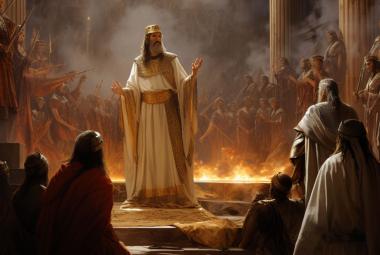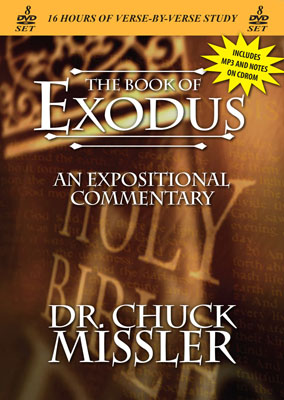They went down to Egypt as a family. They emerged as a nation: "My Firstborn" God called them.1 We all know the story. Or do we?
Moses, trained as a potential heir to the throne of Pharaoh, exiled to Midian for 40 years, encounters the famed flame: a bush that could not be consumed. A rather strange idiom for God to use.
Jesus said, "Not one yot or one tittle shall pass from the Torah until all be fulfilled." (In Hebrew, a "yot" is the tiny mark you and I would mistake for an apostrophe. A "tittle" is the decorative hook on certain letters. This analogous to "dotting an 'i'" or "crossing a 't.'") What did He mean? Are we to take the text of the Torah that seriously? Are there hidden meanings tucked away behind the strange details and figures of speech?2
We should not be surprised that the Holy Spirit continually exploits puns, allegories, metaphors, similes, and other "figures of speech." (Our book, Cosmic Codes, includes a review of over 200 rhetorical devices used in the Bible!)
Let's examine this famous "Burning Bush" episode more closely.
The Strange Burning
It apparently was an acacia bush (shittah) - the thorn - bush of the desert.3 To the rabbinical mind, the thorn denotes sin, being a symbol of the curse of Genesis 3, and, significantly, borne by Jesus at His crucifixion.4 What was so distinctive so as to attract Moses' attention was that it was burning but not consumed. What does this uniqueness signify Levitically?
Fire, of course, speaks of judgment. "Our God is a consuming fire."5 It even speaks of eternal punishment.6 But here we have an image of sin being judged, but not consumed! What can this signify? Only the Grace of God!
It is always the grace of God that attracts us - not His righteousness. His holiness and righteousness terrifies us - as indeed it should. It was His grace that attracted Moses and changed the course of history. (We should remember this when we approach others on His behalf. It is always grace which attracts.)
An Echo of Noah's Flood?
Moses' calling ultimately leads to the Passover, celebrated to this day each year on the 14th of Nisan. This ancient deliverance was also a foreshadowing of our own "Passover" -Jesus Christ. John the Baptist introduced Jesus publicly with the remarkable title, "Behold the Lamb of God that taketh away the sin of the world!"7 Jesus, too, was crucified on the 14th of Nisan.8 Resurrected on the third day, it is startling to realize that our new beginning in Christ was on the very anniversary of the new beginning of the Planet Earth!9
The Two Rock Fountains
Remember the incident at Meribah when the Israelites needed water to drink and God instructed Moses specifically to strike the rock, which he did, and the water was then provided?10
In a second similar instance, God instructed Moses to simply speak to the rock.11 However, Moses - in his exasperation with his own people - struck the rock with his rod as he did on the previous occasion.
What makes this situation so disturbing is that for Moses' failure to follow God's instructions precisely he was not allowed to enter the Promised Land!12 He was only allowed to view it from Mount Nebo before his death, but not allowed to accompany his charges during their entry. What a blow!
It is generally taught that Moses simply misrepresented God to the people in letting them think that God was angry; and, perhaps, also appearing to take credit for the provision.13 In any case, this strikes many as a bit severe. After 40 years of faithful, strenuous, and often frustrating service, this misfeasance denied him his lifetime dream.
But there is also an additional possibility. If Moses had followed God's specific instruction, these two events might have served as a macrocode of the two comings of the Messiah, in which only the first occasion involved the rock being smitten. Paul reveals that, idiomatically, the "rock" was a code for Christ.14 Is it possible that one aspect of Moses' unfortunate performance was that an intended macrocode was thus blown?15
Replete With Macrocodes
We could go on and on. The Book of Exodus, in addition to being one of the most dramatic narratives in the Bible, is also full of macrocodes and other cryptic devices embroidering the presentation of God's program of redemption.
Our space here is too limited to even list other examples, such as the famous plagues brought on Egypt, which anticipate the judgments in the Book of Revelation, and the remarkable details of the peculiar portable sanctuary known as "the Tabernacle," specified in Exodus 24-32. Every detail of this strange structure - including the materials and their dimensions - speaks of Jesus Christ and the plan of man's ultimate redemption. This background alone is one of the most provocative studies a Christian can undertake in the Bible.
This article is to encourage you to undertake a careful and investigative study of this remarkable and fundamental book. There is far more here than was ever even considered in Cecil B. DeMille's Ten Commandments or the recent animated movie, The Prince of Egypt. A study of the real story would be a great project for the summer leisure time. Good hunting!
See below for our new Expositional Commentary on Exodus or our new book, Cosmic Codes - Hidden Messages From the Edge of Eternity.
Notes:
- Exodus 4:22.
- Proverbs 25:2.
- The Acacia seyal (the gum-arabic tree) is also called the "shittah" tree (Isa 41:19) Its wood is called shittim wood (Ex 26:15,26 25:10,13,23,28) etc. It is like the hawthorn, a gnarled and thorny tree. It yields the gum-arabic of commerce.
- Genesis 3:18; Matthew 27:29.
- Deut 4:24; 9:23; Heb 12:29.
- Mt 5:22; Mark 9:44; Rev 14:10; 21:8
- John 1:29.
- For a review of the prophetic implications of all seven Mosaic feasts, see The Feasts of Israel.
- Genesis 8:4. In Exodus 12:2, the Hebrew calendar was changed to make Nisan (previously the 7th month) "the beginning of months." The resurrection of Christ was on the 3rd day: 14 + 3 = 17th.
- Exodus 17:5-6.
- Numbers 20:7-11.
- Numbers 20:12; Deuteronomy 34:4.
- Numbers 20:10.
- 1 Corinthians 10:4.
- A macrocode is an anticipatory literary device which lays out, in advance, a structure or program.







